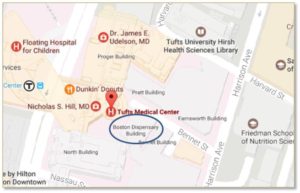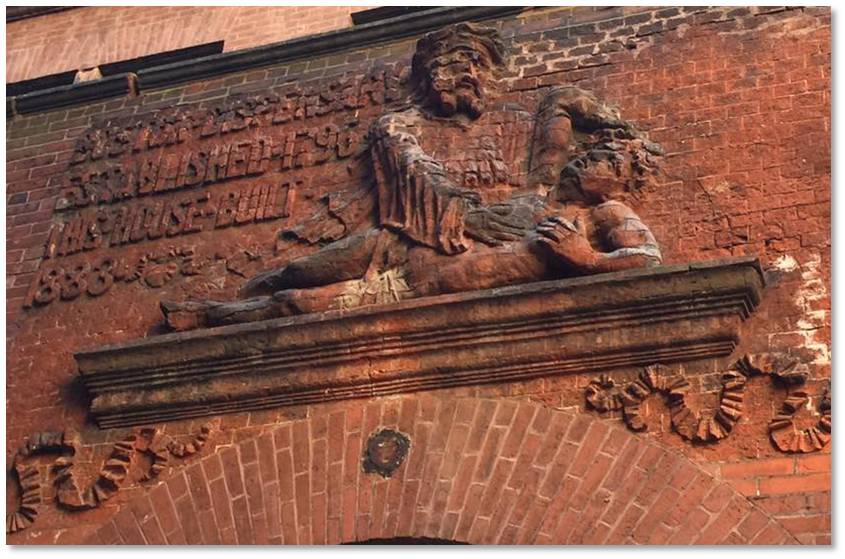Following up on last week’s post about The Good Samaritan on the Ether Monument, here’s our second version of the same motif. You will have a more difficult time finding our second Good Samaritan, however, as he appears on a wall of the old Boston Medical Dispensary building at 29 Bennett Street.
The Boston Dispensary
Founded in 1796 by a group of prominent citizens, the Boston Dispensary, or Boston Medical Dispensary provided free “medical relief of the poor” from the late 18th century into the mid-20th century.
In 1883 a new structure replaced the original building to provide adequate facilities for the charitable work. Patients who were well enough to travel received treatment at this Central Clinic while a staff of 12 district doctors made house calls. (Today only the very wealthy can afford this kind of “concierge” medical care.) The Boston Dispensary was, in fact, the only institution that provided free medical care to those too sick to leave their beds.
Many physicians were trained at the Boston Dispensary including Dr. Oliver Wendell Holmes, Dr. Henry Bowditch, Dr. Benjamin D. Appleton and Dr. Edward Warren.
The Boston Dispensary was funded with a subscription of $5 a year per members, who could then recommend two patients for treatment. This money was were supplemented by fund-raising activities such as a production of King Lear and the first exhibition of an Egyptian mummy. (it was very popular.)
The 1883 Building
The new building was designed by Clarence S. Luce in the English Queen Anne Revival Style. Deep recessed window bays outlined in rough-stone granite mark the red brick façade. The entry porch, treated as an arched portico, is dated with the year the building opened, Triangular pediments accentuate the chimney stacks.
In its day, the Central Clinic had a greater presence in the neighborhood. Today it is dwarfed by the buildings of the Tufts Medical Center complex.
The Good Samaritan Above the Door
Anyone entering the front door would automatically lift their eyes to see The Good Samaritan on the wall above the porch. The cut-brick bas relief was executed in Philadelphia-pressed brick laid in English Portland cement. It copies a 1797 painting executed by Boston artist John Johnston of the firm of Johnston and Crea. The Dispensary paid him the sum of $30 (about $784 today).
This painting hung inside the Dispensary along with a wooden carving of the same subject that was willed to the Dispensary by printer and inventor Benjamin Dearborn and which occupied the lower waiting hall where patients sat on benches.
This image of selfless charity and aid to the injured quickly became the symbol of the Boston Dispensary. It was important enough to be depicted in the drawing, as a squiggle above the door.
The Boston Medical Dispensary Today
Later additions to the Central Clinic building in 1890 and 1899, along with the acquisition of the Trott House at 37 Bennett Street, increased the clinic’s space to include laboratories and pharmacies. The Boston Dispensary merged with the Floating Hospital for Children and the Pratt Diagnostic Clinic/Tufts Medical Center Hospital in the 1960s.
The building at the corner of Bennett and Ash streets remains, however, as does the bas relief of The Good Samaritan.
Information and Directions
 As promised, this building can be difficult to find. Once much longer, Bennett Street is now a small street that ends at Tufts Medical Center. The easiest way to locate the Good Samaritan it is on foot. Think of it as a scavenger hunt.
As promised, this building can be difficult to find. Once much longer, Bennett Street is now a small street that ends at Tufts Medical Center. The easiest way to locate the Good Samaritan it is on foot. Think of it as a scavenger hunt.
I first saw him on Boston By Foot’s Chinatown Tour but it’s not one of the regularly scheduled tours.
You can park in the Tufts Shared Services parking garage. The fastest route is to walk through the big lobby and out the back revolving doors. If you want to go around Tufts Medical Center, walk down Washington Street to Nassau Street. Turn left on Harrison Avenue and then left again on Bennett Street. Proceed nearly to the end of the street. The Boston Dispensary’s Central Clinic building is the last brick building on the left. The entrance, with the Good Samaritan above it, is on the west side so turn left when you pass the building.
The nearest MBTA stops are Tufts Medical and Chinatown. You can visit the Good Samaritan and reward yourself with lunch or dinner in one of Chinatown’s excellent restaurants.



I learn so much about Boston history through these posts!!! Love them.
Wow. I had no idea about any of this. How interesting!